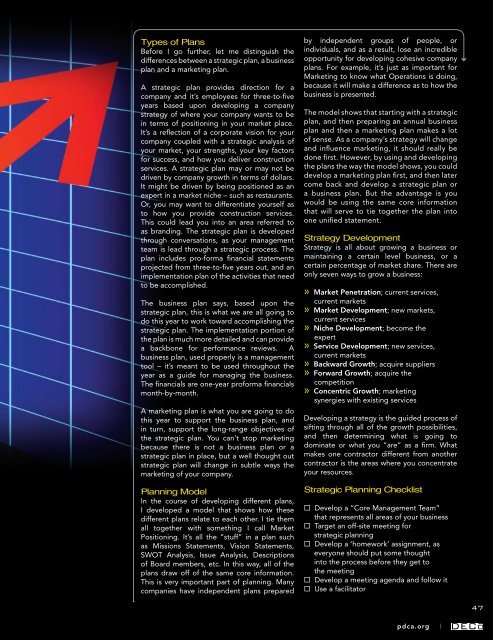n o v/d e c • 2 0 0 8 - Subscribe
n o v/d e c • 2 0 0 8 - Subscribe
n o v/d e c • 2 0 0 8 - Subscribe
Create successful ePaper yourself
Turn your PDF publications into a flip-book with our unique Google optimized e-Paper software.
Types of Plans<br />
Before I go further, let me distinguish the<br />
differences between a strategic plan, a business<br />
plan and a marketing plan.<br />
A strategic plan provides direction for a<br />
company and it’s employees for three-to-five<br />
years based upon developing a company<br />
strategy of where your company wants to be<br />
in terms of positioning in your market place.<br />
It’s a reflection of a corporate vision for your<br />
company coupled with a strategic analysis of<br />
your market, your strengths, your key factors<br />
for success, and how you deliver construction<br />
services. A strategic plan may or may not be<br />
driven by company growth in terms of dollars.<br />
It might be driven by being positioned as an<br />
expert in a market niche – such as restaurants.<br />
Or, you may want to differentiate yourself as<br />
to how you provide construction services.<br />
This could lead you into an area referred to<br />
as branding. The strategic plan is developed<br />
through conversations, as your management<br />
team is lead through a strategic process. The<br />
plan includes pro-forma financial statements<br />
projected from three-to-five years out, and an<br />
implementation plan of the activities that need<br />
to be accomplished.<br />
The business plan says, based upon the<br />
strategic plan, this is what we are all going to<br />
do this year to work toward accomplishing the<br />
strategic plan. The implementation portion of<br />
the plan is much more detailed and can provide<br />
a backbone for performance reviews. A<br />
business plan, used properly is a management<br />
tool – it’s meant to be used throughout the<br />
year as a guide for managing the business.<br />
The financials are one-year proforma financials<br />
month-by-month.<br />
A marketing plan is what you are going to do<br />
this year to support the business plan, and<br />
in turn, support the long-range objectives of<br />
the strategic plan. You can’t stop marketing<br />
because there is not a business plan or a<br />
strategic plan in place, but a well thought out<br />
strategic plan will change in subtle ways the<br />
marketing of your company.<br />
Planning Model<br />
In the course of developing different plans,<br />
I developed a model that shows how these<br />
different plans relate to each other. I tie them<br />
all together with something I call Market<br />
Positioning. It’s all the “stuff” in a plan such<br />
as Missions Statements, Vision Statements,<br />
SWOT Analysis, Issue Analysis, Descriptions<br />
of Board members, etc. In this way, all of the<br />
plans draw off of the same core information.<br />
This is very important part of planning. Many<br />
companies have independent plans prepared<br />
by independent groups of people, or<br />
individuals, and as a result, lose an incredible<br />
opportunity for developing cohesive company<br />
plans. For example, it’s just as important for<br />
Marketing to know what Operations is doing,<br />
because it will make a difference as to how the<br />
business is presented.<br />
The model shows that starting with a strategic<br />
plan, and then preparing an annual business<br />
plan and then a marketing plan makes a lot<br />
of sense. As a company’s strategy will change<br />
and influence marketing, it should really be<br />
done first. However, by using and developing<br />
the plans the way the model shows, you could<br />
develop a marketing plan first, and then later<br />
come back and develop a strategic plan or<br />
a business plan. But the advantage is you<br />
would be using the same core information<br />
that will serve to tie together the plan into<br />
one unified statement.<br />
Strategy Development<br />
Strategy is all about growing a business or<br />
maintaining a certain level business, or a<br />
certain percentage of market share. There are<br />
only seven ways to grow a business:<br />
» Market Penetration; current services,<br />
current markets<br />
» Market Development; new markets,<br />
current services<br />
» Niche Development; become the<br />
expert<br />
» Service Development; new services,<br />
current markets<br />
» Backward Growth; acquire suppliers<br />
» Forward Growth; acquire the<br />
competition<br />
» Concentric Growth; marketing<br />
synergies with existing services<br />
Developing a strategy is the guided process of<br />
sifting through all of the growth possibilities,<br />
and then determining what is going to<br />
dominate or what you “are” as a firm. What<br />
makes one contractor different from another<br />
contractor is the areas where you concentrate<br />
your resources.<br />
Strategic Planning Checklist<br />
� Develop a “Core Management Team”<br />
that represents all areas of your business<br />
� Target an off-site meeting for<br />
strategic planning<br />
� Develop a ‘homework’ assignment, as<br />
everyone should put some thought<br />
into the process before they get to<br />
the meeting<br />
� Develop a meeting agenda and follow it<br />
� Use a facilitator<br />
pdca.org |<br />
47








